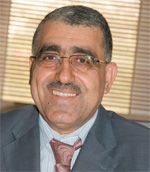Hassan Sultan, the President of the Qatar Oryx Chapter of ASHRAE, in a free-wheeling interview with B Surendar, on the activities planned for the year and on issues related to IEQ and district cooling…
Hassan Sultan, the President of the Qatar Oryx Chapter of ASHRAE, in a free-wheeling interview with B Surendar, on the activities planned for the year and on issues related to IEQ and district cooling…
 How busy are you going to be this summer?
How busy are you going to be this summer?
In June, of course, we are partnering with the HVAC exhibition here in Doha, in which we are taking care of the technical presentations; in addition to this, we will be exhibiting as ASHRAE to announce who we are and what we do. We will, then, be going to the ASHRAE Summer Meeting in Denver. We will be participating from Qatar and will be part of some of the technical committees.
How much has the Chapter grown over the years?
We are 290 members strong. In the context of the Chapter, June is going to be an important month. On June 27, we will be hosting a presentation by Qatar University, whose students have conducted research on geothermal systems. The day will see the launch of the first ever ASHRAE Student Chapter in Qatar. Around 32 students of the Mechanical Engineering Department of Qatar University have expressed willingness to be the first members of the Student Chapter. To float a chapter, you need only 10 members, so things are looking good on that front. After Qatar University, we will move to see if we can have another branch there within the Texas A&M University at Qatar.
Further in the year, the Oryx Chapter will be hosting the CRC (Chapters Regional Conference) in Doha. The CRC will be from the 26th to the 28th of September. And in February 2014, the Chapter will be hosting the 1st International Conference on Energy & IEQ for hot-climate countries.
Speaking of which, how much is the awareness on IEQ in Qatar?
Things are improving on the IEQ front in Qatar. For close to five years, there have been several conferences on IEQ in Qatar. They have focused on awareness and on how to change the behaviour to minimise the risk of gases, non-filtrated air and VOCs in buildings.
I believe the awareness-spreading stage is complete, so everyone understands the importance of noise, filtration, air diffusion and humidity. We are doing a couple of projects with GSAS and the LEED-rating system where IEQ is an issue.
Could you share with the readers the progress on the district cooling front?
We are seeing a large district cooling scheme going up in Lusail. Broadly speaking, there are clear instructions from the Government to take care of energy efficiency in buildings in order to reduce energy consumption. The Government is assisting and advising people to adopt district cooling, but at the same time, the Government will not force anybody to take the district cooling route.
Indeed, there are some clients who want to be independent and don’t want to be linked to a chilled water system. That way, they believe they are controlling the maintenance and other aspects. But with the passage of time, the average of those people is decreasing, which is good. As ASHRAE, we are advising people to take up district cooling for the benefit of the whole country.
Is there enough TSE, though?
There is a decision that has been taken that, whenever a district cooling scheme goes up, the provider has to approach Ashghal to get TSE, but unfortunately, there is not enough TSE. I believe they are working on it, though. It should be polished TSE, or we can ask the cooling tower or chiller manufacturer to cope with the TSE that is available.
Till enough TSE is available, the authorities have allowed the use of potable water. That is the current situation.
Besides the issue of a shallow seafront, is there a deterrent to adopting seawater cooling in Qatar?
We are confronted with two issues, really. One has to do with the Ministry of Environment, because with seawater cooling, we are looking at thermal effluents and the negative impact at the location. They might agree to the scheme rejecting the water at where no one is swimming, though. The second issue is the cost. To build a seawater-intake system is a project in itself.
Copyright © 2006-2025 - CPI Industry. All rights reserved.